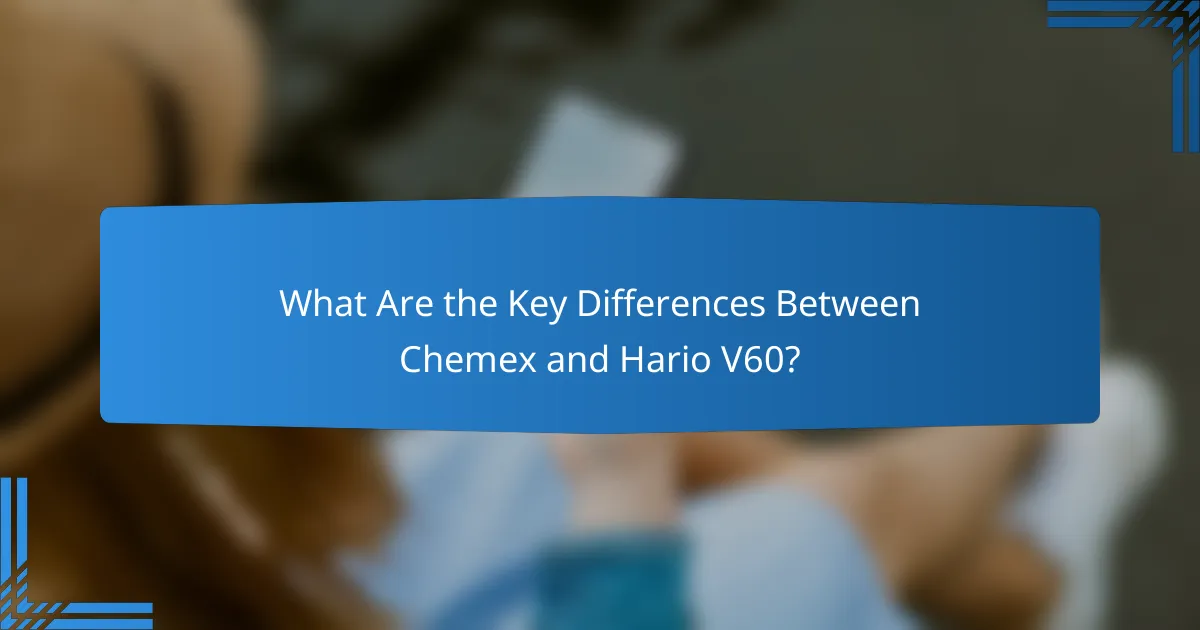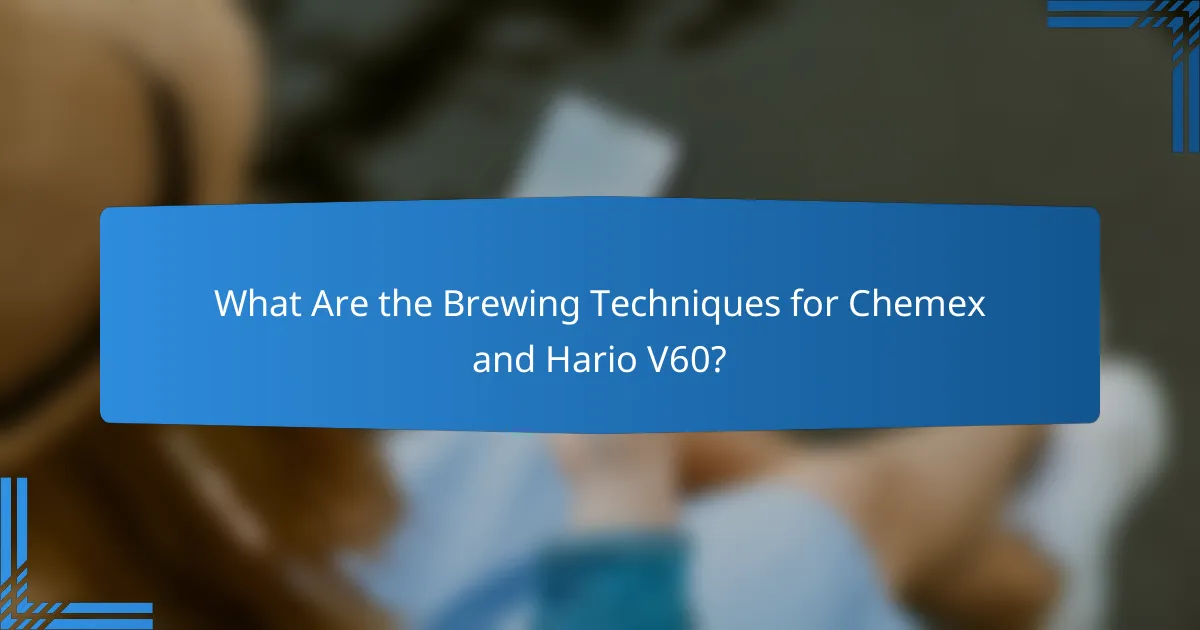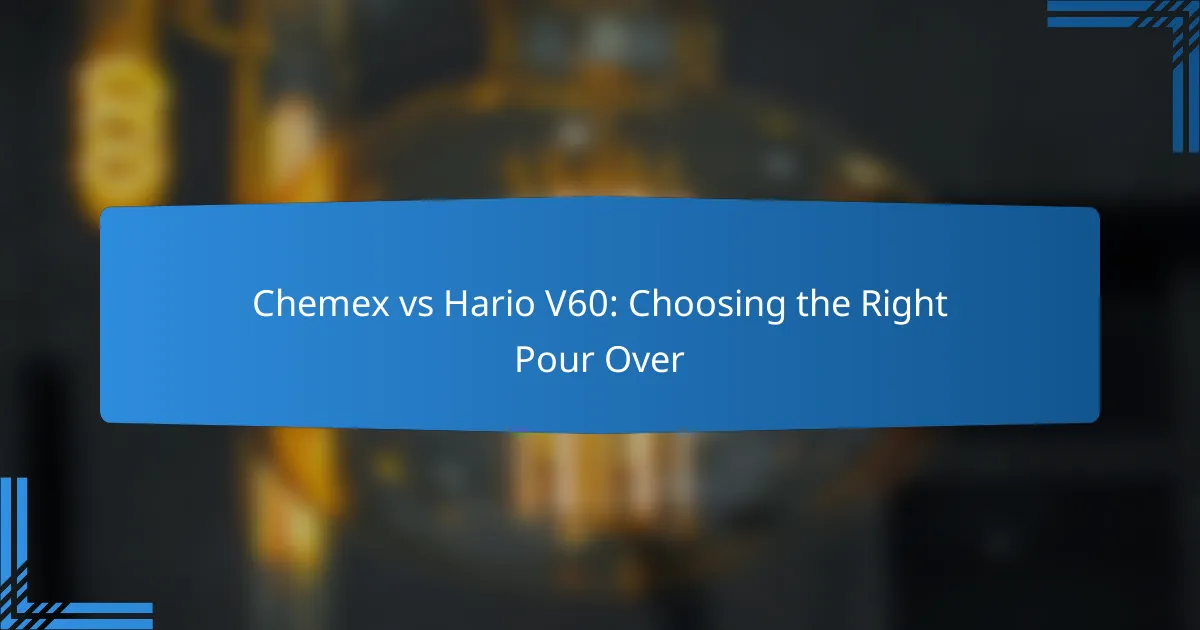The Chemex and Hario V60 are two popular pour-over coffee makers, each offering unique advantages for coffee enthusiasts. While the Chemex is often favored by beginners for its simplicity and elegant design, the Hario V60 allows for greater control over brewing variables, making it ideal for those looking to refine their technique. Understanding the differences in design, brewing time, and flavor extraction can help you choose the right option to suit your coffee preferences.

Which Pour Over Method Is Better for Beginners?
For beginners, the Chemex is often considered the more user-friendly pour over method due to its straightforward design and brewing process. However, the Hario V60 provides more control over brewing variables, which can be beneficial as one gains experience.
Chemex is user-friendly
The Chemex features a simple design that allows for easy brewing. Its thick paper filters help eliminate oils and sediment, resulting in a clean cup of coffee. Beginners appreciate the minimal equipment needed and the clear instructions that come with it.
To brew with a Chemex, you typically need coarsely ground coffee, hot water, and the Chemex itself. The process involves adding coffee to the filter, pouring hot water in a circular motion, and letting it drip. This straightforward method reduces the chances of making mistakes.
Hario V60 offers more control
The Hario V60 allows for greater control over various brewing parameters, such as water temperature, grind size, and pouring technique. This flexibility can lead to a more personalized cup of coffee, but it may also be overwhelming for those just starting out.
Using the V60 requires a bit more attention to detail. You can experiment with different grind sizes and water flow rates to influence flavor extraction. While this method can yield excellent results, it may take some practice to master.
Both methods require practice

What Are the Key Differences Between Chemex and Hario V60?
The Chemex and Hario V60 are both popular pour-over coffee makers, but they differ significantly in design, brewing time, and flavor extraction. Understanding these differences can help you choose the right one for your coffee preferences.
Brewing time varies
The brewing time for Chemex typically ranges from 4 to 6 minutes, while the Hario V60 can brew coffee in about 2 to 4 minutes. The Chemex’s thicker filters and larger capacity contribute to a longer extraction time, which can enhance the complexity of flavors. If you prefer a quicker brew, the Hario V60 is a more efficient option.
Flavor profiles differ
Coffee brewed in a Chemex tends to have a clean and bright flavor profile, often highlighting fruity and floral notes. In contrast, the Hario V60 can produce a more balanced cup with a fuller body, allowing for a wider range of flavor nuances. Your choice may depend on whether you enjoy a lighter, more delicate taste or a richer, more robust experience.
Filter types impact taste
The Chemex uses thicker paper filters, which trap more oils and sediment, resulting in a cleaner cup. The Hario V60, with its thinner filters, allows more oils to pass through, contributing to a richer mouthfeel. Experimenting with different filter types can further influence the taste, so consider trying various options to find your ideal brew.

How Do Chemex and Hario V60 Compare in Price?
The Chemex and Hario V60 vary significantly in price, impacting your initial investment and ongoing costs. Chemex tends to be pricier upfront, while the Hario V60 offers a more budget-friendly option for coffee enthusiasts.
Chemex is generally more expensive
The Chemex coffee maker typically ranges from around $40 to $60, depending on the size and design. This higher price point reflects its unique glass craftsmanship and aesthetic appeal, making it a popular choice for those who value both function and style.
In addition to the initial cost, Chemex brewers require specific filters that can add to your overall expenses. These filters are thicker and designed to enhance the brewing process, but they can be more costly than standard filters used with other pour-over methods.
Hario V60 is budget-friendly
The Hario V60 is known for its affordability, with prices generally falling between $10 and $30. This makes it an accessible option for coffee lovers who want to explore pour-over brewing without a significant financial commitment.
Moreover, the Hario V60 is compatible with a variety of filters, allowing users to choose more economical options. This flexibility can lead to lower overall costs for those who brew coffee regularly.
Long-term costs of filters
In contrast, Hario V60 filters are typically less expensive, with options available for as low as $0.10 each. This difference can significantly impact your budget if you enjoy brewing coffee frequently, making the Hario V60 a more economical choice in the long run.

What Are the Best Coffee Beans for Each Method?
The best coffee beans for Chemex and Hario V60 depend on the roast profile and flavor preferences. Chemex typically excels with medium roasts, while Hario V60 shines with light roasts, allowing for distinct flavor notes to emerge.
Medium roast for Chemex
Medium roast coffee beans are ideal for Chemex brewing due to their balanced flavor profile. This roast level retains some acidity while offering a fuller body, making it suitable for the Chemex’s unique brewing method, which emphasizes clarity and sweetness.
When selecting medium roasts, look for beans from regions like Central America or Colombia. These beans often provide a harmonious blend of chocolate and nutty flavors, enhancing the overall experience when brewed in a Chemex.
Light roast for Hario V60
Light roast coffee beans are best suited for the Hario V60, as they highlight the intricate flavor notes that this brewing method can extract. The V60’s design allows for precise control over the brewing process, making it perfect for showcasing the bright acidity and floral notes found in lighter roasts.
Consider beans from Ethiopia or Kenya, which are known for their vibrant fruitiness and floral characteristics. These beans can produce a complex cup that reflects the unique qualities of the coffee when brewed with the Hario V60.
Single-origin recommendations
Single-origin coffee beans can elevate both Chemex and Hario V60 brewing methods, offering unique flavor profiles tied to their specific regions. For Chemex, look for single-origin beans from Guatemala or Costa Rica, which often present a balanced cup with sweet and fruity notes.
For the Hario V60, consider single-origin beans from Colombia or Panama, known for their bright acidity and diverse flavor profiles. Experimenting with different origins can reveal exciting taste experiences tailored to your brewing method of choice.

What Equipment Is Needed for Each Pour Over?
Choosing between a Chemex and a Hario V60 involves understanding the specific equipment required for each method. Both options have unique needs that can influence your brewing experience and the flavor profile of your coffee.
Chemex requires a carafe
The Chemex is a distinctive glass carafe that serves as both the brewing vessel and the serving container. It features a unique design that allows for optimal extraction of coffee flavors while also being aesthetically pleasing. When using a Chemex, you will need specially designed Chemex filters, which are thicker than standard filters and help remove oils and sediment.
Consider the size of the Chemex carafe you choose, as they come in various capacities, typically ranging from 3 to 10 cups. A larger carafe is ideal for brewing multiple servings at once, while a smaller one is suitable for single servings or smaller households.
Hario V60 needs a dripper
The Hario V60 is a cone-shaped dripper that sits atop your coffee cup or carafe. This device allows for a more controlled brewing process, as you can adjust the pouring technique and water temperature to influence the extraction. The V60 requires specific filters that fit its shape, which are generally paper, but metal and cloth options are also available.
When selecting a Hario V60, consider the material options available, such as ceramic, plastic, or glass. Each material affects heat retention and brewing time, so choose one that aligns with your preferences and brewing style.
Common accessories for both
Regardless of whether you choose a Chemex or Hario V60, several accessories can enhance your brewing experience. A gooseneck kettle is essential for precise pouring, allowing you to control the water flow and direction. A scale is also recommended to measure coffee and water accurately, ensuring consistent results.
Other useful accessories include a coffee grinder for fresh grounds, a timer to track brewing time, and a thermometer to monitor water temperature. Investing in these tools can significantly improve the quality of your pour-over coffee.

What Are the Brewing Techniques for Chemex and Hario V60?
The Chemex and Hario V60 are both popular pour-over coffee methods, each with distinct brewing techniques that influence flavor and extraction. Understanding these techniques can help you choose the right method for your coffee preferences.
Chemex uses a slow pour
The Chemex brewing method requires a slow, controlled pour to achieve optimal extraction. This technique involves pouring hot water over coffee grounds in a circular motion, allowing the water to saturate the grounds evenly. The process typically takes around 4 to 5 minutes from start to finish.
One key aspect of the Chemex is its thick paper filters, which remove oils and fine particles, resulting in a clean and crisp cup of coffee. However, this also means that the brewing process can be slower compared to other methods, as the water needs time to pass through the filter and extract flavors.
To master the Chemex, aim for a water-to-coffee ratio of about 15:1. Start with a medium grind size and adjust your pouring technique to maintain a steady flow. Avoid pouring too quickly, as this can lead to under-extraction and a sour taste.
